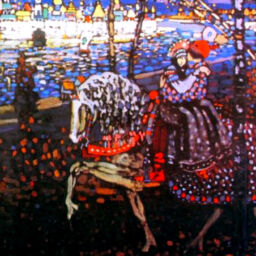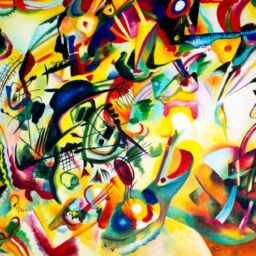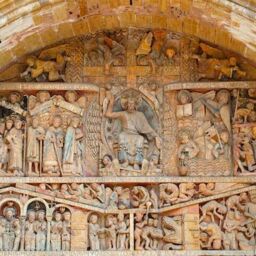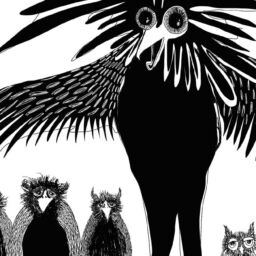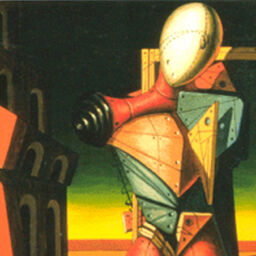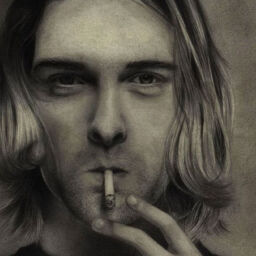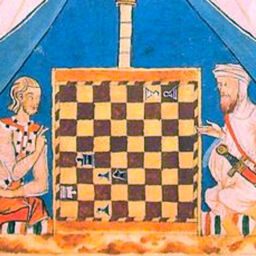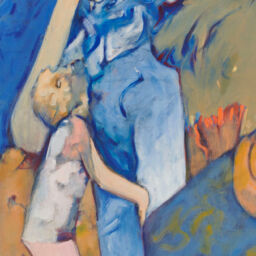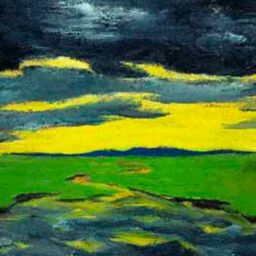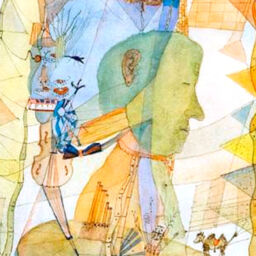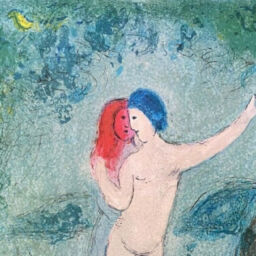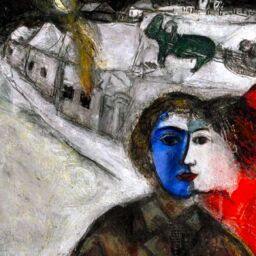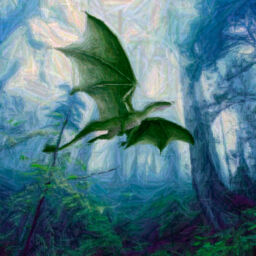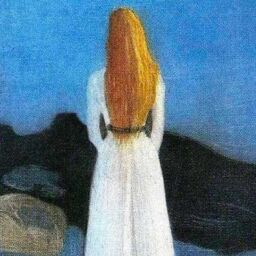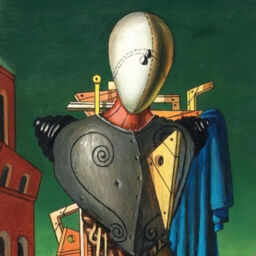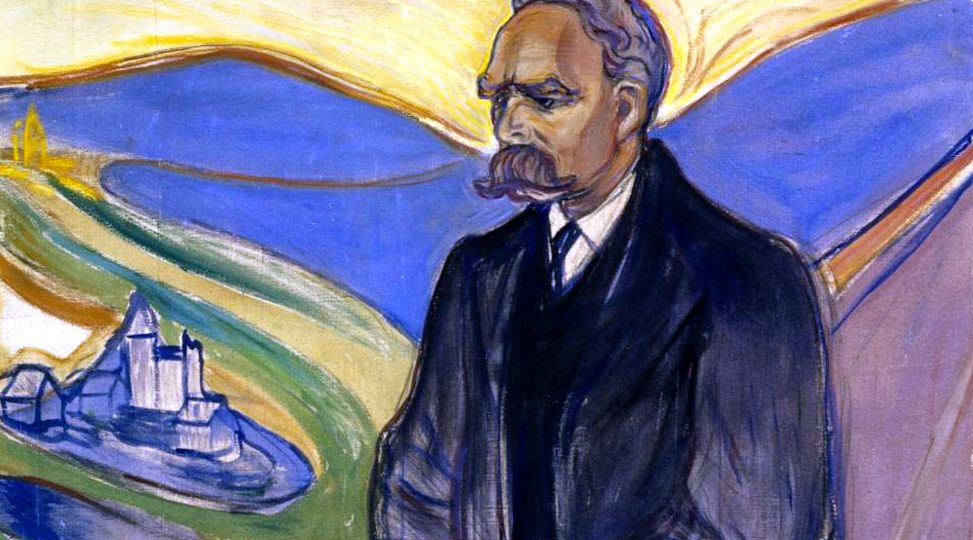
Nietzsche on “Self-Overcoming”
Genius, Hubris, and Disintegration
James Kennard, July 1, 2015
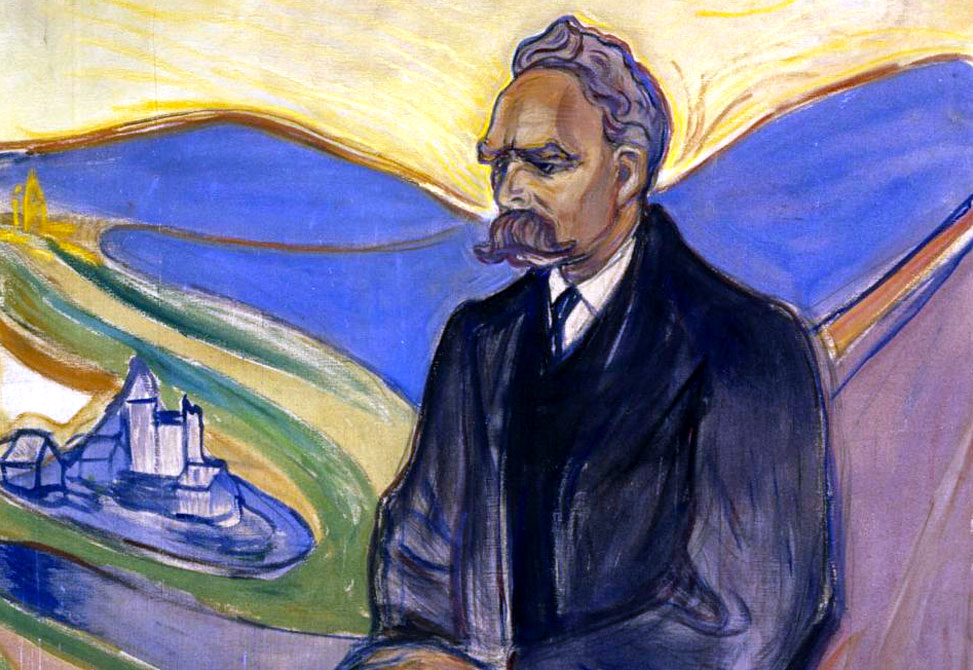
Psychological Types was a theoretical break from the main interest of depth psychology which was then exclusively concerned with the investigation of the unconscious. The book reflects Jung’s premise that knowing more about the way we experience reality provides us with a self-reflective, epistemological basis for making psychological inquiry. As John Beebe (2004) put it, “Consciousness, in this sense, was [for Jung] the indispensable investigative tool for all further work on the unconscious” (p. 87).
In Psychological Types, Jung (1921/1971) recognized Nietzsche as an example of the irrational perceiving type: a dominant introverted intuitive who had largely “freed himself,” in Jung’s words, from the auxiliary thinking function:
Nietzsche made far greater use of the intuitive source and in so doing freed himself from the body of the intellect in shaping his philosophical ideas. …If one can speak of intuitive method at all, Zarathustra is in my view the best example, …a vivid illustration of how the problem can be grasped in a non-intellectual and yet philosophical way. (para. 540)
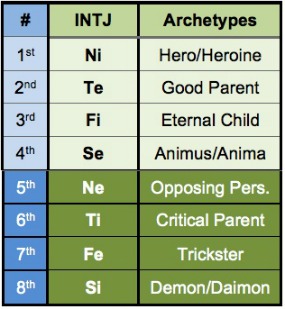
Quoting Faust, Nietzsche (1968/1992) discloses his own one-sided intuitive style: “Should not my longing overleap the distance and draw the fairest form into existence?” (p. 26). This indicates a dominant intuitive who, in attaining far-reaching conclusions, then chooses not to engage any other function. As a result, the dominant process gets carried away with itself, losing connection with reality. Toni Wolff spoke during Jung’s seminar describing this aspect of the work as follows:
Nietzsche, as far as he identifies with Zarathustra …has just preached that man ought to grow beyond himself in the Superman. But Nietzsche does not grow, he does not take roots by assimilating the shadow. Instead he identifies with the vision, and so it becomes a sort of trick, like walking on air. (as cited in Jung, 1988/1998, p. 62)
Nietzsche’s connection with reality is directed through the vertical axis, or what Beebe calls the spine of integrity, into extraverted sensation as his inferior function. Typically, this connection is supported by the auxiliary function, which for Nietzsche was Thinking. As Jung (1988/1998) said, “In Nietzsche’s case, this inferior side is sensation-feeling, because he is in the conscious [state] chiefly intuitive, with thinking in the second position” (p. 295). The philosophy of Zarathustra is that of the Übermensch or over-man who “tries to build up an attitude or a system by which one can overcome that terrible shadow which undermines and checks every movement” (Jung, 1988/1998, p. 68). Rather than truly being able to move down to embrace the inferior function, to achieve what Beebe (1992) calls “integrity in depth,” he tries to “overcome” the problem of the personality. Nietzsche’s fantastic intuitions are not wholly thought through, and so he is not able to deal with the real task of individuation, which asks us to ground consciousness in the reality of body and mind (psyche as a whole). To this somatic end, a good metaphysical idea should not upset the stomach (Jung, 1988/1998, p. 99). Paying attention with these other modes of knowing is part of our movement toward greater differentiation, what Jung called the process of individuation.
Typology and Individuation—The Golden Flower
Typology is the essential groundwork for Jung’s later theoretical elaborations on the archetypal unconscious. Jung said personality type is not static, but that it develops in the course of life. The emergence of these new forms of experience, or ways of knowing, occurs through a conscious engagement with the individuation process. Further differentiation is made by our continued adaptation to psyche and the world. Consciousness is then a part of—and arises from—our relationship with psyche in the environment. This psychological work involves consciousness adapting to new situations, on the way to becoming more whole or complete persons. New standpoints emerge, to unfold the basic structure or pattern of the personality, where life is experienced in its fullness. We become more complex, while at the same time continuing to relate through this basic typological structure, as psyche moves toward an image of wholeness.
Our continued adaptation is a matter of necessity, which we know through our daily interactions with the environment. Jung speaks to this psychological need in these seminars, through the image of a wild elephant who tosses a woman sleeping on a pile of bananas: “Life wants to get at its result and if you don’t chime in, then you are cast out like nothing at all, as if you never had been. And then the experiment is made again” (1988/1998, p. 123). The individuation process is this kind of life experiment, which requires our attention in different ways. It occurs through encounters with these other aspects of the Self, seen through archetypal figures such as the wise old man or woman, the Trickster, or the Puer Aeternus/Puella Aeterna. Zarathustra is the figure Jung calls the wise old man. These are the archetypal forms contained in the larger circumference of being, known as the collective unconscious. Jung’s (1953/1968) opus was later dedicated to the uncovering of this process, which he saw depicted most eloquently through alchemical imagery.
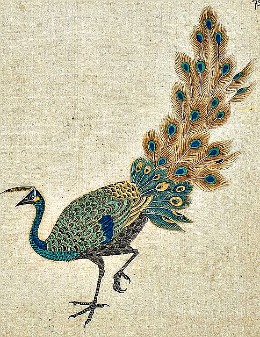
The highest hope is the star. Man should plant a germ, which would grow up in the form of a plant, and the plant would create a flower. It is what we would call the Yoga plant, with the star flower. It is an age-old poetical metaphor to call a meadow full of flowers an image of the sky with its thousands stars; flowers have those starlike forms, symmetrical structures. (1988/1998, p. 53)
Jung draws the parallel here between the structure of the flower and scintillating power of the star. The symbol expresses the development in the psyche, and more importantly, an experience of “the ‘true May,’ when the heavenly flowers bloom and the secret of the inner man is made manifest” (Jung, 1967/1983, p. 163). The symmetrical shape of the flower describes the structure of the personality given in his typological theory, the quaternity of four functions or eight function-attitudes. As Jung noted in his Alchemical Studies (1967/1983), “the orienting system of consciousness has four aspects, which correspond to four empirical functions …this quaternity is an archetypal arrangement” (p. 167). John Beebe later amplified this schema by associating eight specific archetypal energies to accompany the function positions, thus including the shadow in the complete structure. This squared circle is the basic outline of the mandala, the archetypal image of the Self. Jung (1967/1983) used this archetypal image to depict the pattern of individuation, so that “when the self finds expression in such drawings, the unconscious reacts by enforcing an attitude of devotion to life” (p. 24). The personal pattern is contained in this larger circle, the greater circumference of psyche, the archetypal unconscious. “Integrity in depth” moves the personal self-structure into alignment with an “instinctive knowledge of how to live, [so it] can be [more] authentically accessed” (Beebe, 1992, p. 94).
Nietzsche called these deeper functions “virtues,” from the Latin virtus, which means dynamic quality (Jung, 1988/1998 p. 264). The cultivation of these wild virtues, qualities, or powers, amounts to a fulfillment of their potential, in relationship to consciousness. The differentiation of the personality here synchronizes with these larger archetypal patterns of experience, the mythic images in the night sky. The light of the sun or the dancing movement of the star provides us with the essential movement, or rotation around the center. Nietzsche says here: “It is your dearest Self, your virtue. The thirst of the ring is in you: to reach itself again, struggleth every ring, and turneth itself” (as cited by Jung, 1988/1998, p. 262). The centripetal movement of psyche thus emanates from the dynamic element in the virtue. Individuation unfolds through the different functions, and this movement of consciousness is held within certain archetypal patterns or constellations.
Jung (1967/1983) further evidenced this quaternity of psychic functions in alchemical literature through the work of Paracelsus and Dorn, where the lumen naturae are also known as Scaiolae, “mental powers and virtues, properties of the arts of the mind” (p. 169). Realizing these unique forms of consciousness amounts to fulfilling one’s individual pattern, which brings us again to Beebe’s archetypal model. He notes that Jung’s theory of individuation has often been associated with nineteenth century notions of progress, while “Jung’s own way of speaking about the growth of consciousness tended to be simpler, and …more soulful” (2004, p.88). Beebe quotes Jung, who was once asked: “Does consciousness help in the process of individuation?” To that he replied:
Living consciously is our form of individuation. A plant that is meant to produce a flower is not individuated if it does not produce it—and the man who does not develop consciousness is not individuated, because consciousness is his flower—it—is his life. (as cited in Beebe, 2004, p. 88)
The many petals of this flower are the different functions of our type. The many figures of the archetypal unconscious will often relate to the different stages of this process, wherein the individual participates in the uncovering of these new centers of experience. Jung’s (1967/1983) work on the Chinese alchemical text, The Secret of the Golden Flower, perfectly illustrates this point. It describes the creation of a “diamond body” through the “germinal vesicle” or golden flower. This is often depicted as “a structure in brilliant fiery colours growing out of a bed of darkness, and carrying the blossom of light at the top” (p. 15).
Concerning the emergence of multiple conscious phenomena, this is often experienced as a psychic fragmentation, or dis-integration of consciousness. This forms part of the inherent danger in the work, but is also a necessary phase in the movement toward greater complexity, or wholeness. In Nietzsche, we see this fragmentation beginning to occur with the appearance of Zarathustra, where in his home in Sils-Maria, he wrote:
I sat there waiting, waiting – not for anything.
Beyond Good and Evil, enjoying soon the light,
Soon the shade, now only play, now
The lake, now the noon, wholly time without end.
Then suddenly, friend one became two —
And Zarathustra passed me by.
(as cited by Jung, 1988/1998, p. 10)
This is what we call a personification, the appearance of another personality in the psyche. Hillman (1960/1999) also knew this “devilish duplicity of consciousness,” as the appearance of a daimon (p. 71). According to Edinger’s (1984) definition of consciousness, we know that it “is made up of two factors— ‘knowing’ and ‘withness’ …that is, in a setting of twoness” (p. 36). Zarathustra is the appearance of twoness in consciousness, an autonomous factor that comes to define his unique style, a star-like ruling planetary system in the psyche. Jung distinctly saw that Nietzsche then became completely identified with this archetypal figure, and then also one-sided in his approach—pathologically intuitive. Swallowed up by Zarathustra’s archetypal enthousiasmos, he abandoned critical thinking processes. Without that critical distance, he “could not [but] help assuming such an identity, [especially] in those days when there was no psychology. Nobody would then have dared to take the idea of personification seriously” (Jung, 1988/1998, p.10).
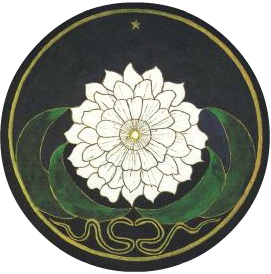
Nietzsche attacks and criticizes “the last-man” who is the common person, and the inferior part of himself, which stubbornly refuses to individuate. He is not able to see and accept this ordinary part of himself which relates through extraverted sensation: “They have left the regions where it is hard to live [i.e. the heights of intuitive awareness], for they need warmth. One still loveth one’s neighbor and rubbeth against him; for needeth warmth” (as cited by Jung, 1988/1998, p. 54). We see the connection with his humanity imaged through the sensation of rubbing together, which is connected with the idea of love. The theme of self-love is part of the desire to individuate, constituting the essential drive behind the movement. Self-love, or what Nietzsche calls selfishness, is often thwarted through his introverted isolation. Jung (1988/1998) explains:
Now “love thy neighbor as thyself” is really a very profound formula; of course a more extraverted mood insists upon the neighbor, and a more introverted mood insists upon yourself. …To fall into the extraverted principle and follow the object and forget about yourself is just like going into the wilderness and losing humanity. We always make ourselves victims of the opposites. Therefore, we are only right in following this prescription. (p. 245)
Through his introverted identification with Zarathustra, das Übermensch (the over-man), Nietzsche loses a connection with reality, and becomes a victim of his opposite. Sensation here constitutes “the real world” and the life of the body, and a connection with humanity. His is a rather violent movement, uprooting consciousness from its home, the dark soil of the undifferentiated psyche. Without any support from the other functions, this movement inevitably breaks what Beebe calls the spine of integrity, the primary axis of his personality structure.
Typological Analysis
The primary nodal points (intuition and sensation) emerge in Thus Spoke Zarathustra (1954/1995) to form the essential twoness or polarity in Nietzsche’s personality. This axis of integrity is given in the very first passage of the book:
When Zarathustra was thirty years old he left his home and the lake of his home and went into the mountains. Here he enjoyed his spirit and his solitude, and for ten years did not tire of it. But at last a change came over his heart, and one morning he rose with the dawn, stepped before the sun, and spoke thus:
You great star, what would your happiness be had you not those for whom you shine?
For ten years you have climbed my cave: you would have tired of your light and of the journey had it not been for my eagle and serpent. (p. 9)
This poetic image of consciousness is given in terms of the light of the sun, which shines for two animals, the primary elements of his personality. The eagle has a quality of vision that belongs to the height of his Intuition. The serpent is an even more ancient creature of the earth, embodying the element of inferior Sensation.
To provide some context, Nietzsche’s first published work was The Birth of Tragedy in 1872. It is a truly modern archetypal critique of culture, so modern that it was not understood during his lifetime. He was a genius without a sense of place. This contributed to the development of an inferiority complex, which resulted in the first book on power psychology, The Will To Power, a posthumously published collection of his writings. Enter Zarathustra, an extraverted defense mechanism and archetypal compensation. This is a case of “libido that will not flow into life at the right time [so it] regresses to the mythical world of the archetypes” (Jung, as cited by Segal, 1998, p. 85).
The story continues, as the personification of the Self (Zarathustra) acknowledges the need to connect with people. This would constitute a movement back into the world, where Nietzsche might be able reach his own humanity:
Behold, I am weary of my wisdom, like a bee that has gathered too much honey; I need hands outstretched to receive it…
For that I must descend to the depths, as you do in the evening when you go behind the sea and still bring light to the underworld, you overrich star.
Like you, I must go under—go down, as is said by man, to whom I want to descend. (1954/1995, p. 10)
This mythic image, the light of consciousness descending into the depths of the sea, is also an essential movement in the course of individuation. Von Franz (1971/2013) notes, “you have to come down, and that means a relative lowering of the level of the personality. …One has to sacrifice a certain amount of striving for moral perfection to avoid building up too black a counterposition” (p. 87). Jung considered Zarathustra to be both an archetypal figure of the wise old man, and a psychopomp, or guide of the soul into the underworld. As such, Zarathustra is a product of unconsciousness, an autonomous psychic fragment that overcompensates for Nietzsche’s real need for recognition. This is a personification of the neurotic intuitive, who chooses a “forced exaggeration of the conscious attitude” (Jung, 1921/1971, para. 663).
Again, this overcompensation is seen in Nietzsche’s forward to The Birth of Tragedy (1968/1992), where he introduces Zarathustra as a continuation of the Dionysian spirit. After quoting Faust, he goes further to say:
Raise up your hearts, my brothers, high higher! And don’t forget your legs! Raise your legs, too, good dancers; and still better; stand on your heads! (p. 26)
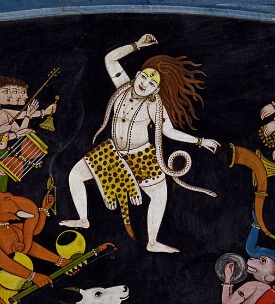
I am convinced that even an introvert can use an extraverted mechanism if he uses the way of the inferior function.
Nietzsche …would use the extraverted mechanism, the Dionysian way. But you see both [extraversion and introversion] in Nietzsche’s case. He was first a professor at the University of Basel, but he was not quite understood, so he locked himself away with his complex and lived quite isolated. Then the unconscious came up with all its extraversion and this time he locked the complex away from himself and dissolved in a tremendous extraversion within his isolation. (p. 78)
The Dionysian extraversion of his inferior sensation usurps Nietzsche’s world just as quickly as it brought the possibility of new consciousness into existence. Inevitably, the inflated creative aspect of Nietzsche, intuition, becomes destructive. We see the aspect of critical reflection taking a back seat to the intuitive flights of fantasy, where he is not able to differentiate the archetypal content from the function. Counter to this, Jung (1988/1998) says: “Mystics knew remoteness from God was essential to union with God” (p.148). The tremendous numinosity of Zarathustra requires an indirect approach, which in Nietzsche’s case begins with the thinking function. Critical reflection would distance consciousness from this all-too powerful source revelation and thus depotentiate the “extraverted” psychic image. According to the thinking of James Hillman (1976/1992), this would help psychologize, or see through the mythical content to the archetypal background.
Without this psychological distance, Nietzsche becomes possessed by Zarathustra, who preaches an over-estimation of the body: “Behind the thoughts and feelings, my brother, is a mighty lord and sage—it is called Self; it dwelleth in thy body, it is thy body” (as cited by Jung, 1988/1998, p.111). Zarathustra confuses the power of the Self with the body, which is both a complete reversal of the spiritual values of Christianity, and Nietzsche’s own intuitive orientation. He lives in a cloud of archetypal ideas, and cannot acknowledge or accept the wisdom of the body, knowledge afforded by somatic experience. This particular wisdom of Zarathustra belongs to introverted sensation (Si), Nietzsche’s Demonic/Daimonic function. According to the Beebe model, the area that is the most profoundly ego-dystonic also affords the most radical possibility of redemption. Jung (1988/1998) accords with this view, knowing that “to an intuitive-intellectual the source of revelation is the body” (p. 191).
In the translator’s notes to Thus Spoke Zarathustra (1954/1995), Walter Kauffman expresses the agony Nietzsche lived with, including periods of stomach cramps with bloody vomiting, migraines, fevers, and hemorrhoids, and bad vision that granted him only an hour and a half of vision per day:
But Nietzsche despises this hygiene of the body and works at his desk for ten hours, and for this excess his overheated brain takes revenge with raging headaches and a nervous overcharge; at night when the body becomes weary, it does not permit itself to be turned off suddenly, but continues to burrow in visions and ideas until it is forcibly knocked out by opiates. (p. 4)
This gives a very personal account of Nietzsche’s relationship with his body, which explains the numinous force he felt behind it. He cannot tolerate the psychological significance of the experience, and works to overcome it in spite of his suffering. In this next section, we get a taste of what Jung called the “reality-alienating subjectivity of this [introverted sensation] type” (1921/1971, para. 651), revealed in terms of Nietzsche’s tremendous amount of physical suffering: “But then you, my enemies, stole my nights from me and sold them into sleepless agony. …All nausea I once vowed to renounce: then you changed those near and nearest to me in putrid boils” (p. 110).
In Nietzsche’s (1954/1995) descent through the underworld, “The Tomb Song” (p. 110), we see the simultaneously destructive and redeeming aspect of the psyche revealed. Jung (1988/1998) says this passage concerns “Nietzsche’s approach to himself. It is a sort of descent to his inferior function” (p. 289). Again, we see the “inferior function” in terms of a shadow possession. Here too, we find the Demonic 8th function position, an introverted sensing experience, where “all impressions sink into the depths and hold consciousness under a spell” (Jung, 1921/1971, p. 397). This amounts to the same thing in terms of a katabasis, which “is leading now to the precincts of the unconscious …the ghost land, the land of the dead” (Jung, 1988/1998, p. 289):
“There is the isle of tombs, the silent isle; there too are the tombs of my youth. There I wish to carry an evergreen wreath of life.” Resolving thus in my heart, I crossed the sea.
O you visions and apparitions of my youth! …How quickly you died. Today I recall you like dead friends. …For once I possessed you, and you still possess me. …I am still the heir of your love and its soil, flowering in remembrance of you with motley wild virtues. (Nietzsche, 1954/1995, p. 110)
This rotation of the psyche illuminates the darkest layer of the inherited personality structure, the Demonic function “flowering in remembrance.” These are the undead aspects of the personality that can “still possess,” control, or abduct the conscious standpoint. This profoundly ego-dystonic psychic element leads directly into the next section, “On Self-Overcoming,” which describes an anabasis or ascent, an attempt at rebirth. Hence it reflects the transformation that the lowest function can achieve from Demonic to Daimonic; Nietzsche’s redemption through the Daimonic 8th function contains the archetypal influence of the over-man, “an ancient will to power:”
How did I endure it? How did I get over and overcome such wounds? How did my soul rise again out of such tombs?
Indeed, in me there is something invulnerable and unburiable, something that explodes rock: that is my will …
Invulnerable am I only in the heel. …Indeed for me you are the shatterer of all tombs. Hail to thee, my will! And only where there are tombs are there resurrections. (p. 112)
This very clearly describes his identification with the archetypal energy of Zarathustra, the “invulnerable and unburiable.” It is descriptive of the numinosum, the virtue of a god. The personal will is actually relatively small and the strength of the ego limited, compared with the greater forces of instinctual life. In Zarathustra however, this power of the lowest is connected with the “highest hope.” This uroboric “thirst of the ring” is the archetypal striving of consciousness to reach new levels of freedom. Identification with this daimon is a hubristic, albeit heroic, movement out of the mythic underworld tomb, “where mother, womb, the pit, and hell are all identical” (Neumann, 1954/1995, p. 158). The mythical hero seeks to untether himself from the former reality of psyche. Consciousness thus attempts to sunder its umbilical connection to the maternal womb of the unconscious, where “slaying of the mother and identification with the father god go together” (p. 165).
This desire to repress and dismember the body-psyche, expresses the Titanic aspect of the Dionysian archetypal arrangement (Pedraza-Lopez, 2000). To shatter this container is also metaphor for psychological dis-integration. In conjunction with this Titanic inflation, the 8th function position is akin to molten lava, “something that explodes rock” (Nietzsche, 1954/1995, p. 112). It is both the most destructive, and powerful element in the psyche. As such the Achilles heel, or psychologically weakest point, he also considers the greatest strength. As in the image of an upside-down Dionysian dancer, we see this inversion of the personality structure expressed again:
While such flooding can sometimes enrich the personality, it can also in acute and chronically dysfunctional situations represent a disastrous compensatory attempt by the unconscious to replace a failing ego with archetypal modes of adaptation …[which] can produce even more pathology than was present before the organism mustered its defenses. (Sandner & Beebe, 1995, p. 328).
This archetypal mode of adaptation leads to his possession by Zarathustra and a final fateful catastrophe imaged very early in the book. Zarathustra moves down the mountain, in amongst “the flies of the marketplace:”
When Zarathustra came into the next town, …many people had been gathered together in the marketplace, for it had been promised that there would be a tightrope walker. And Zarathustra spoke thus to the people:
“I teach you the overman. Man is something that shall be overcome. What have you done to overcome him?”
…“Man is a rope, tied between beast and overman—a rope over an abyss. A dangerous across, a dangerous looking-back, a dangerous shuddering and stopping.” (Nietzsche, 1954/1995, p. 12)
Once the sermon has been given, the promised tightrope walker begins the dangerous journey across. Just as he is halfway, a small door opens and a jester emerges: “Forward, lamefoot! He shouted in an awe inspiring voice.” This recalls the very words of Zarathustra himself, who derides the “last-man,” and preaches the“overman.” The joker then tickles his heel and jumps over the tightrope walker, crossing the line to win. The walker loses “balance” and falls to his death. Zarathustra comforts the dying man, in saying: “Your soul will be dead even before your body: fear nothing further” (pp. 19-20). This expresses the whole problem of the inferior function in a nutshell. In attempting to go directly down into the unconscious, across the vertical axis, he loses balance and is overcome by the shadow. Jung (1988/1998) said, “whatever we split off which belongs to us, will follow and eventually overtake us” (p. 284).
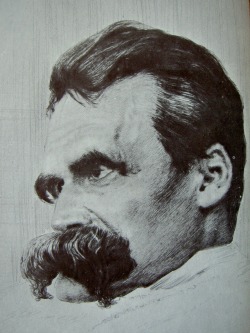
While there are psychological reasons for Nietzsche’s decline, we also know that he had syphilis, which he apparently contracted from a prostitute. It is here we see psychological and physical reality as truly two sides of the same coin. This syphilitic infection in the brain could be described as the revenge of his inferior extraverted sensation. He was not able to have any consciousness around this function, and could only “express a low-down sexuality” (Jung, 1988/1998, p.165). This was kept away from him, repressed, and so returned with a vengeance. That is the very nature of the god Dionysius, who avenges his detractors with real madness.
References
Beebe, J. (1992). Integrity in depth (pp. 102-109). College Station, TX: Texas A & M University Press.
Beebe, J. (2004). Understanding consciousness through the theory of psychological types. In J. Cambray, and L. Carter (Eds.), Analytical psychology: Contemporary perspectives in Jungian analysis (pp. 83-115). Hove, UK: Brunner-Routledge.
Cousins, N. (n.d.). Quotes.net. Retrieved May 31, 2015, from http://www.quotes.net/quote/4131.
Edinger, E. (1984). The creation of consciousness. Toronto, CA: Inner City Books.
Hillman, J. (1976/1992). Re-visioning psychology. First Harper Perennial Ed. New York, NY: Harper Collins Publishers.
Hillman, J. (1960/1999). The myth of analysis: Three essays in archetypal psychology. 3rd Printing. Evanston, IL: Northwestern University Press.
Jung, C. G. (1921/1971). General description of the types (R.F.C. Hull, Trans.). In H. Read et al. (Series Eds.), The collected works of C.G. Jung (Vol. 6, pp. 330-407). Princeton, NJ: Princeton University Press.
Jung, C. G. (1953/1968). Psychology and alchemy. (R. F. C. Hull Trans.) (2nd ed.). From The collected works, Vol. 12. London, UK: Routledge.
Jung, C. G. (1960). On the nature of psyche. (R. F. C. Hull Trans.) (1st ed.). Bollingen Series XX, Vol. 8. Princeton, New Jersey: Princeton University Press.
Jung, C. G. (1967/1983). Alchemical studies (R. F. C. Hull, Trans.). The collected works of C.G. Jung (Vol. 13). Bollingen Series XX. Princeton, NJ: Princeton University Press.
Jung, C. G. (1988/1998). Jung’s seminar on Nietzsche’s Zarathustra. Abridged Ed. Jarrett, J. L. Bollingen Series XCIX. Princeton, NJ: Princeton University Press.
Nietzsche, F. (1968/1992). The birth of tragedy. In Basic writings of Nietzsche. Kaufmann, W. (Trans.). Modern Library Edition. New York, NY. Random House, Inc. (Original work published 1872)
Nietzsche, F. (1954/1995). Thus Spoke Zarathustra. Kaufmann, W. (Trans.). Modern Library Edition. New York, NY. Random House, Inc. (Original work published 1883)
Neumann, E. (1954/1995). The origins and history of consciousness. Hull, R. F. C. (Trans.). Bollingen Series XLII. Princeton, New Jersey: Princeton University Press.
Pedraza-Lopez, R. (2000). Dionysus in exile: On the repression of the body and emotion. Willamette, IL. Chiron Publications, Inc.
Sandner, D. & Beebe, J. (1995). The role of psychological type in possession from Psychopathology and analysis. In M. Stein (Ed.), Jungian analysis (2nd ed., pp. 322-330). Chicago, IL: Open Court.
Segal, R. (1998). The function of myth. In Jung on mythology. Princeton, NJ: Princeton University Press.
von Franz, M.-L. (1971/2013). The inferior function. In Hillman, J. & von Franz, M-L.,Lectures on Jung’s typology. Dallas, TX: Spring Publications.
Images
Edvard Munch, “Portrait of Friedrich Nietzsche,” 1906. Courtesy: Thiel Gallery.
Zhou Hu and Zhou Xi, “Peacock,” 1644.
Anon. (patient of C. G. Jung), “Golden Flower Mandala,” prior to 1929, publication date of Jung’s Commentary on The Secret of the Golden Flower.
Anon., “Lord Shiva dancing,” 1700-1800. Courtesy: National Museum, Delhi.
Hans Olde, “Portrait of Fredrich Nietzsche,” 1899-1900.



